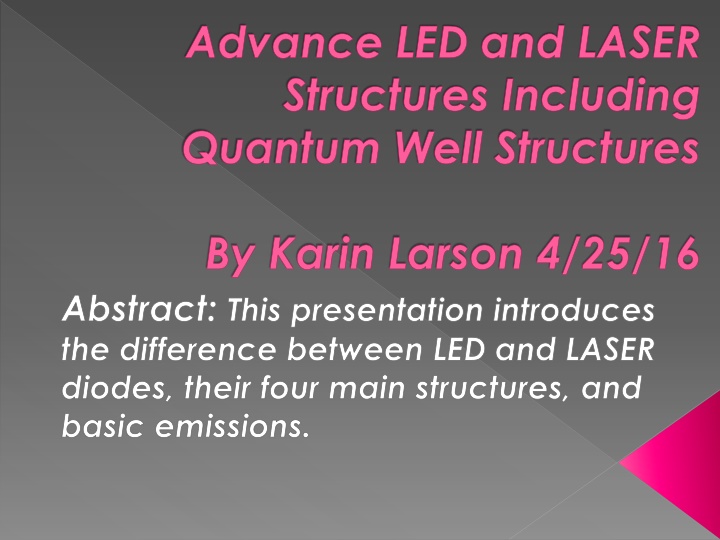LED and Laser Diodes: A Comparative Analysis
This presentation by Karin Larson compares LED and laser diodes, covering their structures, emissions, and fundamental differences. Explore homostructure, single heterostructure, double heterostructure, and quantum well structures in the context of LED and laser technologies.
Download Presentation

Please find below an Image/Link to download the presentation.
The content on the website is provided AS IS for your information and personal use only. It may not be sold, licensed, or shared on other websites without obtaining consent from the author.If you encounter any issues during the download, it is possible that the publisher has removed the file from their server.
You are allowed to download the files provided on this website for personal or commercial use, subject to the condition that they are used lawfully. All files are the property of their respective owners.
The content on the website is provided AS IS for your information and personal use only. It may not be sold, licensed, or shared on other websites without obtaining consent from the author.
E N D
Presentation Transcript
Advance LED and LASER Structures Including Quantum Well Structures By Karin Larson 4/25/16 Abstract: This presentation introduces the difference between LED and LASER diodes, their four main structures, and basic emissions.
Outline LED vs LASER Homostructure Single Heterostructure Double Heterostructure Quantum Wells Edge and Surface Emissions
LED and LASER Electroluminescence Reliable and long lifespan due to small size Mass produced at low cost Release a photon by an electron moving from a high state to a lower one
LED Light Emitting Diode Mostly Monochromatic Light from spontaneous emission Significantly divergent Incoherent light
LASER Light Amplification by Stimulation of Emitted Radiation Single wavelength Light by stimulated emission Little divergence Coherent light
Homostructure p-n homojuction Both p and n are heavily doped Excess carriers are spread by diffusion Thickness of the active region is generally a few micrometers Impractical for LASER diodes
Single Heterostructure Replace p region with a P-p heterojunction to restrict diffusion Creates a P-p-n diode Causes a defined active layer in p region
Double Heterostructure Can be either P-p-N or P-n-N There is now a heterojunction on each side of the active region Better than single heterostructures Active region 100-300nm High efficiency and large optical gain Less absorption loss
(Treharne) (Liu)
Quantum Well Double heterostructure when the active region is much smaller Splits conduction and valence bands into sub-bands The required injection current density is required than of a DH Much higher gain Gain bandwidth is typically 20-40THz
Edge Emission Categorized by broad-area and stripe- geometry (Liu)
Surface Emission Categorized into broad and small area (Liu)
Conclusion In general LEDs and LASER diodes have a lot of similarities with a few defining differences Adding in heterojunctions leads to more control over the active region and refining the refractive index Quantum wells are DH structures with a reduced active region and are much better Light emissions can either be from the edge or the surface of the diode
References "Cr dits Des Ressources." Specific Applications of Sensors for Photonic and Imaging. N.p., n.d. Web. 20 Apr. 2016. <http://www.optique- ingenieur.org/en/courses/OPI_ang_M05_C04/co/OPI_ang_M05_C04_web_2.ht ml>. Farrell, Gerald. "Laser Structures." Optical Communications Systems: Semiconductor Laser Diodes (n.d.): n. pag. Laser Structures. Dublin Institute of Technology, 2002. Web. 20 Apr. 2016. <http://www.electronics.dit.ie/staff/gfarrell/LaserPhotodiodes/4Laserdiodestruc t.pdf>. Larsen, Adrien P. "LASER vs. LED: What s the Difference?" Acupuncture Technology News. N.p., 11 Feb. 2014. Web. 20 Apr. 2016. <https://www.miridiatech.com/news/2014/02/laser-vs-led-whats-the- difference/>. Liu, Jia-Ming. "Semiconductor Lasers and Light Emitting Diodes." Photonic Devices. Cambridge: Cambridge, 2005. N. pag. Knovel. Web. 20 Apr. 2016. "Potential Well." Wikipedia. Wikimedia Foundation, n.d. Web. 20 Apr. 2016. <https://en.wikipedia.org/wiki/Potential_well>. Treharne, Robert. "Lecture 5: Junctions." Lecture 5: Junctions. Slide Share, 6 Nov. 2014. Web. 20 Apr. 2016. <http://www.slideshare.net/RobertTreharne/lecture-5- junctions>. "Quantum Well Laser." Wikipedia. Wikimedia Foundation, n.d. Web. 20 Apr. 2016. <https://en.wikipedia.org/wiki/Quantum_well_laser>.
5 Key Points The main differences between LED and LASER diodes are emission, divergence and coherence The 4 structures are homostructure, single and double heterostructures, and quantum wells Quantum wells are DH s with a smaller active region Light emissions are either from the edge of the diode or the surface In general LEDS have a broader emission configuration while LASER uses smaller























